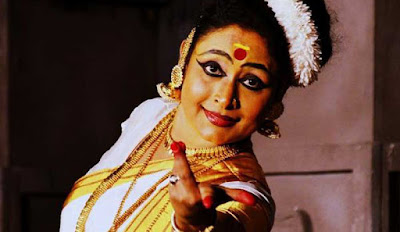ONLINE: Jayaprabha Menon raises climate change awareness through Mohiniyattam recital
 |
| Jayaprabha Menon (courtesy jayaprabhamenon.com) |
Jayaprabha Menon, a leading exponent of Mohiniyattam, performed online in November at an event organized by the Colorado Fine Arts Association, the third South Asian Classical Dance Festival of Colorado. Jayaprabha is a well-known Mohiniattam choreographer and guru as well and is the current director of the International Academy of Mohiniyattam, New Delhi. She has been trained under gurus like Kalamandalam Saraswathy, C.V. Chandrasekhar and Bharathy Shivaji.
Her production was titled ‘Prakriti’ since the theme of the festival was climate change awareness through performing arts. The first piece she presented was an invocation of Lord Ganesha, depicting his attributes of a mukut with the moon, his curled trunk and his worship as the remover of all obstacles. The bees hover on his gandasthala or forehead. With his third eye, he is the destroyer of all evil and the remover of all obstacles. She ended the piece with the stuti ‘Gam Gam Ganpataye Namah’, followed by nritta with bols. The composition was in raag mallika, tala aadi. The execution of the piece in abhinaya by Jayaprabha was impressive.
 |
| Pic courtesy YouTube |
Next, she did an ashtapadi by Jayadeva. Here, the sakhi goes to Radha and describes how Krishna is pining for her and is very distressed since he has not seen her for many days. The bols are ‘Sakhi tapa virahe vanamali’. She is trying to console Krishna, telling him not to cry. The ritu of love heightens his pain. The bees are hovering over his forehead and he has to push them away again and again. The sounds of the birds prick his ears. The flowers are blooming, but their scent does not impress him. The frolicking and playful peacocks are strutting around Krishna and the deer are prancing around him. But none of this diverts him from his pain. The moon, which is shining bright, does not cool the burning of viraha. In fact, it is fanning the fire in his heart, increasing it manifold. The humming bees are deafening him. Right from the time that the day starts and the sun rises, to the night when the day ends, he is in the same state, looking for her. Both the nritta and nritya by Jayaprabha were very impressive, bringing out the pain in Krishna’s heart in the absence of Radha. I also felt somehow that her expressions added a bit of humour to the depiction of Krishna’s state instead of showing it as a grievous infliction.
The piece was rendered with a lot of impressive abhinaya, interspersed sometimes with nritta. The significance of this piece to the next one is that it provides the continuation, following the theme.
 |
| Pic courtesy timesofindia.indiatimes.com |
The final piece was titled ‘Prithvi’. This was in accordance with the theme of the event, which was prakriti or the nature. As Jayaprabha said, mother earth has bestowed riches upon mankind since eternity with all her resources. But due to overexploitation by man, the balance has been tipped and there have been unforeseen calamities in which nature and mankind both have been destroyed. Now, since procreation is one of the basic requirements for life, Kamadeva tries to shoot his arrows and bring back love and romance in nature. But sadly, there are no flowers from which to make arrows and hence his quiver is empty. There is no breeze to fan desires, no fragrance to enhance the romance in nature. So the earth is now lying barren. According to her, it is up to the next generation now to care for Mother Earth and restore the rhythm of nature.
For this piece, the flute and the music created most of the mood of the production. With the music and the rhythm, Jayaprabha depicted the beauty of nature through her nritta, showing the flowers blossoming and the seeds producing more flowers. The wind carries the fragrance in nature, inciting romance. Hence, the entire prakriti or nature is in the mood of love and romance. The music for this bit was very catchy. Then follows the destruction by man, the industrialization, the deforestation, showing massive destruction and the stench coming from the rivers, which have been badly polluted. Actually, the pathos that she created made humankind look like a rampaging devil amid the beauty of the nature. Manav is being asked what state he has brought the earth to: the vegetation is all destroyed, the birds have all flown away, the flowers are wilting, the rivers are polluted, bhoomi has been totally defiled and it is now up to the next generation to restore the damage done. The credit for this piece being very expressive goes not only to the dancer but also to the vocalist and the musicians, who did a wonderful job of creating the varied moods in the production.


Comments
Post a Comment